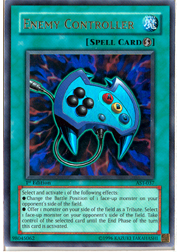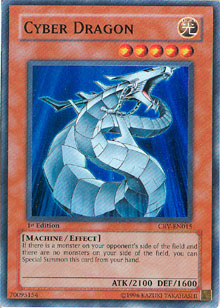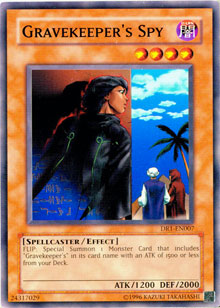One of the neat perks of doing event coverage for Shonen Jump Championships is that I have a chance to see a ton of people of widely varied skill levels playing the game in the most frequent and competitive venue available. Winning an SJC is serious business and every bit of preparation counts when it comes down to whether you make day 2, have a respectable showing, or just plain old scrub out. Of course, many players just skip the whole process and will most likely scrub out, as well they should. What boggles the mind, however, is how players who do put time into building their decks still don’t grasp the full functionality of the cards they put into them. As a reporter who needs to remain silent and impartial while making his rounds through the top tables, it’s truly frustrating to see players with great, unique decks lose because of simple missed opportunities. That’s why I’m proud to announce that the fine folks who run Metagame.com have given me the opportunity to write this column, which I call “The School of Duel.” Every couple of weeks, I’ll take a look at some facet of the game that people often have difficulty understanding or executing. It could be anything from simple misuse of a single card to a more advanced concept such as determining what is or is not an acceptable risk. It’s open to your suggestions as well. Is there something that you’re wondering about or something you see people do that you don’t quite understand? All these things are fair game, and I’ll show you where you can send your questions at the end of the article.
 For the first couple of articles in this series I’m going to stick to some of the most commonly played cards in the new format, and what better place to start than Enemy Controller? The card has been consistently popular since its initial release back in the Ancient Sanctuary set, only really dropping off the map during the period between the 2005 US National Championship and the beginning of October that same year. Starting with SJC Atlanta, Enemy Controller began to appear in nearly every deck out there due to its incredible versatility. Exactly how versatile is it? Here are a few easy problems you can solve in order to get a feel for the different ways the card can be used.
For the first couple of articles in this series I’m going to stick to some of the most commonly played cards in the new format, and what better place to start than Enemy Controller? The card has been consistently popular since its initial release back in the Ancient Sanctuary set, only really dropping off the map during the period between the 2005 US National Championship and the beginning of October that same year. Starting with SJC Atlanta, Enemy Controller began to appear in nearly every deck out there due to its incredible versatility. Exactly how versatile is it? Here are a few easy problems you can solve in order to get a feel for the different ways the card can be used.
- Your opponent has just found a way out of a bad situation. In the last turn, he finally remembered and recovered his Treeborn Frog. He then activated Pot of Avarice to draw two cards. Next, he tributed the Frog to summon the Zaborg the Thunder Monarch he’d been holding to destroy your set Old Vindictive Magician. Finally, he revealed his only other set card, a face-down Mystic Tomato, and switched it to attack mode. The Tomato attacks and destroys your face-down Banisher of the Radiance (Book of Moon flipped it down in response to an attack on Tomato) and Zaborg hits you directly, dropping you to 1400 life points. Your opponent sets both cards from Pot of Avarice—Sakuretsu Armor and Enemy Controller—and ends his turn. On your turn, you draw into another copy of Banisher of the Radiance. You’re holding Cyber Dragon, Enemy Controller, the Banisher, and Premature Burial. Your opponent has 700 life points remaining. Your opponent knows you have an Enemy Controller but is unsure of the identity of the rest of your cards. Using only the given information, win the game this turn if possible. If it is impossible to win this turn, explain why. You may assume that your opponent will do everything in his power to not lose.
- You are currently playing a Monarch Control variant, and you have a Treeborn Frog in defense mode, a face-down Sangan, and a set Enemy Controller. Your opponent has two Hydrogeddon cards on the field and she returns her own Frog to the field. The Frog is quickly tributed for Zaborg the Thunder Monarch, obviously targeting your set monster. You have 4600 life points to her 6000 thanks to an early direct swing with Injection Fairy Lily, and your opponent has not used her third Hydrogeddon. Assume that she knows your set card isn’t Mirror Force and she will thus attack with every monster she manages to summon. The cards in hand for both players are irrelevant, and there are no limited cards in your graveyard; the contents of your Deck are up to you. Survive through this turn and put yourself in the best possible position to stabilize your field position independent of your next draw.
Go ahead and take some time to write up your solutions, I’ll wait . . .
 Experienced players probably found these exercises very simple, but newer players may have a little difficulty. The basic functions of Enemy Controller are simple. You can switch a monster’s position or tribute one of your monsters to take control of one of the opponent’s face-up monsters until the end of the turn. Obviously this is useful for blocking attacks or taking away big monsters so that you can punch through the rest of the opponent’s weak monsters to win the game. These are the factors that come into play in the first problem. The first move is to special summon the Cyber Dragon. At this juncture, your opponent would have the option of immediately tributing one of his monsters to Enemy Controller to take control of your Cyber Dragon and thus prevent you from summoning your own Monarch (assuming you had one). However, if he did this, you could easily win the game. Simply chain your Enemy Controller to the opponent’s, tributing the Cyber Dragon to take control of Zaborg. Then normal summon your Banisher and start swinging. If the opponent doesn’t act upon the summon of the Cyber Dragon, he probably also won’t act if you summon the first Banisher. Stealing it would be essentially pointless because you still haven’t shown any capability to pull off the win (besides attacking with Cyber Dragon into the Tomato, which isn’t going to work). At this point, however, some potential solutions to the problem begin to break down.
Experienced players probably found these exercises very simple, but newer players may have a little difficulty. The basic functions of Enemy Controller are simple. You can switch a monster’s position or tribute one of your monsters to take control of one of the opponent’s face-up monsters until the end of the turn. Obviously this is useful for blocking attacks or taking away big monsters so that you can punch through the rest of the opponent’s weak monsters to win the game. These are the factors that come into play in the first problem. The first move is to special summon the Cyber Dragon. At this juncture, your opponent would have the option of immediately tributing one of his monsters to Enemy Controller to take control of your Cyber Dragon and thus prevent you from summoning your own Monarch (assuming you had one). However, if he did this, you could easily win the game. Simply chain your Enemy Controller to the opponent’s, tributing the Cyber Dragon to take control of Zaborg. Then normal summon your Banisher and start swinging. If the opponent doesn’t act upon the summon of the Cyber Dragon, he probably also won’t act if you summon the first Banisher. Stealing it would be essentially pointless because you still haven’t shown any capability to pull off the win (besides attacking with Cyber Dragon into the Tomato, which isn’t going to work). At this point, however, some potential solutions to the problem begin to break down.
Anyone who begins his or her battle phase without using Premature Burial on the second Banisher cannot win the game this turn. This is because you’ll never have more than the maximum of two attacking monsters. Let’s say you have your Banisher attack the Tomato. The opponent will allow the attack, lose his Tomato to the removed-from-game pile, and drop to 500 life points. Then what do you do? You need to tribute something to Enemy Controller to take control of Zaborg. If you choose Cyber Dragon, you’re probably going to lose next turn. If you tribute Banisher, you do lose next turn: Sakuretsu Armor destroys your Cyber Dragon and Controller shifts Zaborg to defense, allowing its owner to attack directly with it next turn. Even if you resurrect Cyber Dragon with Premature Burial afterwards, you haven’t completed the set task and you’re still in a terrible position going into your opponent’s turn. The opponent only needs a 200 ATK monster to win, 300 if he forgets the Treeborn Frog yet again.
But if you use Premature Burial on the other Banisher, you should definitely win the game through intelligent use of Enemy Controller. Once you have your three monsters, you can order Cyber Dragon to attack the Tomato, and the opponent has to act in order to not lose. If he plays Sakuretsu Armor you need to let it resolve. As long as he has that Enemy Controller and Mystic Tomato, any attempt to steal Zaborg will be thwarted. Let’s say you chain the Controller to steal Zaborg. The opponent then uses his Controller to steal it right back and you lose the game next turn. Alternatively, the opponent could simply chain Controller instead to take control of Cyber Dragon. Then you just chain your Controller (tributing the Dragon) to steal Zaborg, and the game is in the bag.
Let’s return to the first scenario where the opponent destroys your Dragon with Sakuretsu Armor. Your next move is to attack Banisher into the Tomato. The opponent allows the attack and drops to 500 life points. You then activate your Controller to steal the Zaborg, tributing the Banisher that already attacked. Unfortunately, this is a losing proposition for you since the opponent will simply block Zaborg’s hit with his own Controller, causing you to lose next turn. So it looks like the obvious plan of attacking with Cyber Dragon first isn’t so hot, assuming your opponent knows his stuff.
What if you attack with a Banisher first? Then he activates Enemy Controller to steal Cyber Dragon from you. In this case, you chain your Controller, tributing the Dragon to steal Zaborg, and you officially Cannot Possibly Lose™ given that you now have three attackers capable of ending the game and he only has one Sakuretsu Armor. What if he lets the attack through and drops to 500? This is actually the best move the opponent can make assuming that he has knowledge of your Enemy Controller, because it makes it impossible for him to lose this turn. As soon as you try to steal Zaborg with your Controller, he simply chains his to steal your Cyber Dragon. While this won’t stop him from losing next turn (assuming he doesn’t catch an incredible draw like another Zaborg) it does prevent you from winning the game this turn. Thus, the answer to the problem is that you cannot win the game this turn for the reasons that have been discussed above.
Scoring for this Problem:
+5 points for recognizing that you cannot win the game.
+5 points if you explained that it couldn’t be done with just a Dragon and a Banisher.
+10 points if you explained why you can’t do it even if you bring all the monsters out.
+3 points if you said it was possible under the assumption that the opponent would misplay.
Max Score: 20
Let’s move to the next problem. The first part of the problem is relatively straightforward. You only have 4600 life points left and she still has a Hydrogeddon left in the deck. Your best move in terms of minimizing damage and maximizing the potential gain from your next draw is to tribute the Frog to Enemy Controller to take control of Zaborg. I told you in the problem that the cards your opponent has in hand are irrelevant to the current situation, so you can feel safe knowing that the Hydrogeddon cards aren’t going to grow large enough to take down Zaborg. Many people would immediately think of chaining Controller—tributing Sangan to take control of Zaborg—but if you do this, you still have a monster on your field that a Hydrogeddon can take down to bring the third one out of your opponent’s deck, which is never good for you. While this doesn’t necessarily oppose your ability to stabilize your field, it’s still a bad idea. Only half credit for that part if you left the Treeborn on the field.
The other part of the problem is choosing which monster to take from your deck with Sangan. I specifically mentioned two things in to guide you towards the correct choice in this situation. First and most obviously, I mentioned that you currently have no limited cards in your graveyard. Second, I mentioned that you needed to be able to stabilize your field independent of your next draw. The second condition was placed there in order to deter you from choosing Gravekeeper’s Spy with the Sangan and hoping to have it block Hydrogeddon. While a Rush Recklessly might not be enough to get Hydrogeddon to beat a Zaborg in battle, it can take out a Gravekeeper’s Spy. If Zaborg were to take out the first Spy, then there’s a decent chance that she’ll have the Rush to make Hydrogeddon take out the second, and then you’re in trouble.
 Additionally, Spy is dependent on your next draw not being the other (or another) Gravekeeper’s Spy. Spy is useless if Zaborg simply destroys it and then the Hydrogeddon cards get you. Still, Spy remains an effective tool for blocking and tribute fodder generation (though you do have a Frog), so half credit if you picked Spy. To get full credit here (not to mention keeping yourself in the duel regardless of your next draw), you need to pick Spirit Reaper from your deck. While a Rush from the opponent will ruin you even if you do pick the Reaper, it can’t be destroyed in battle by Zaborg, nor does it matter what you draw next turn. All things considered, Spirit Reaper is the best bet here, since it provides absolutely no positive gain for your opponent.
Additionally, Spy is dependent on your next draw not being the other (or another) Gravekeeper’s Spy. Spy is useless if Zaborg simply destroys it and then the Hydrogeddon cards get you. Still, Spy remains an effective tool for blocking and tribute fodder generation (though you do have a Frog), so half credit if you picked Spy. To get full credit here (not to mention keeping yourself in the duel regardless of your next draw), you need to pick Spirit Reaper from your deck. While a Rush from the opponent will ruin you even if you do pick the Reaper, it can’t be destroyed in battle by Zaborg, nor does it matter what you draw next turn. All things considered, Spirit Reaper is the best bet here, since it provides absolutely no positive gain for your opponent.
Scoring:
+5 points if you tributed Treeborn Frog to take control of Zaborg.
+2.5 points if you tributed Sangan to take control of Zaborg.
+5 points if you fetched Spirit Reaper with Sangan’s effect.
+2.5 points if you took Gravekeeper’s Spy
+1 if you picked a chance-based effect monster or Destiny Hero - Defender.
Max Score: 10
Total Score:
- X/20
- Y/10
Total: (X+Y)/30
If you picked up 20 or more points, great job! If you got between 10 and 20 points, that’s still pretty good given the subtleties of many of these situations. If you got less than 10, don’t fret. Read over the various possible outcomes of the two situations carefully until you understand exactly what’s going on. It may help if you actually set the problems up in front of you so that you can see all the cards involved as if it were an actual game.
Remember, this column is all about helping you to increase your abilities as a duelist, so if there are any specific topics that you’d like me to cover, be sure to send them to jcmchale@andrew.cmu.edu. Until next time, play hard, play fair, and, most importantly, have fun!
Jerome McHale
jcmchale@andrew.cmu.edu
HOMEWORK: The next installment of The School of Duel won’t be for a couple of weeks. Until then, work on this problem to get a feel for what we’re going to talk about next week.
You’re playing a Counter Fairy deck and you’ve opened with a hand of Confiscation, Skelengel, Bountiful Artemis, Magic Drain, Negate Attack, and Forced Back. You activate Confiscaton and see that your opponent is holding Zaborg the Thunder Monarch, Nobleman of Crossout, Confiscation, Cyber Dragon, and Dekoichi the Battlechanted Locomotive. His next draw will be a trap card. Assuming that he will immediately activate Confiscation upon the start of his turn and do everything in his power to clear your field, what is your best opening move?
Remember, “best” is in the eye of the beholder, so it’s perfectly natural for people to disagree on this subject. We’ll talk about it more next time. Class dismissed!